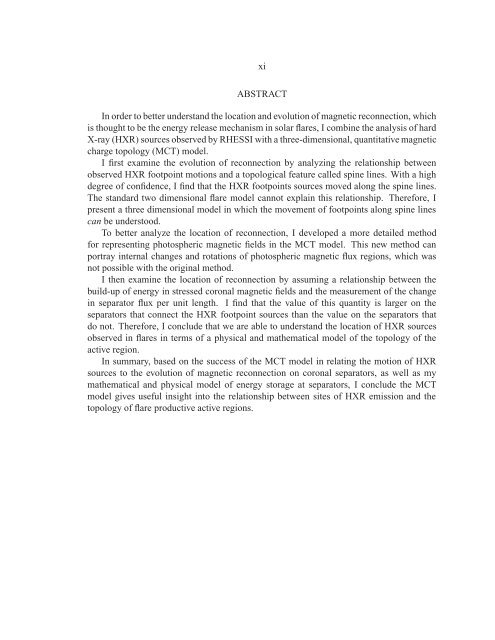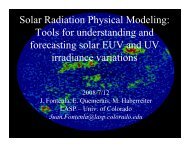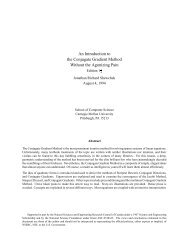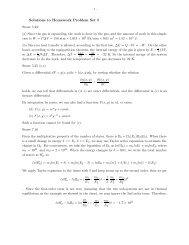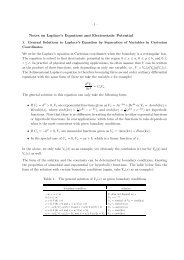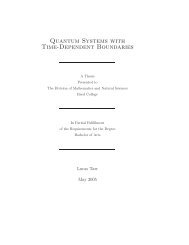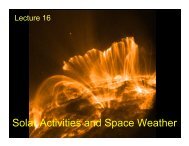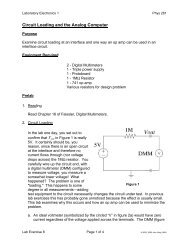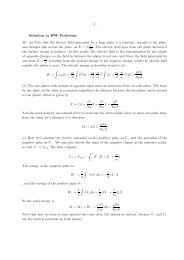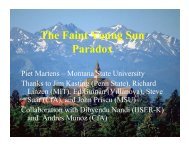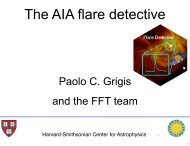The Topology of Magnetic Reconnection in Solar Flares
The Topology of Magnetic Reconnection in Solar Flares
The Topology of Magnetic Reconnection in Solar Flares
You also want an ePaper? Increase the reach of your titles
YUMPU automatically turns print PDFs into web optimized ePapers that Google loves.
xiABSTRACTIn order to better understand the location and evolution <strong>of</strong> magnetic reconnection, whichis thought to be the energy release mechanism <strong>in</strong> solar flares, I comb<strong>in</strong>e the analysis <strong>of</strong> hardX-ray (HXR) sources observed by RHESSI with a three-dimensional, quantitative magneticcharge topology (MCT) model.I first exam<strong>in</strong>e the evolution <strong>of</strong> reconnection by analyz<strong>in</strong>g the relationship betweenobserved HXR footpo<strong>in</strong>t motions and a topological feature called sp<strong>in</strong>e l<strong>in</strong>es. With a highdegree <strong>of</strong> confidence, I f<strong>in</strong>d that the HXR footpo<strong>in</strong>ts sources moved along the sp<strong>in</strong>e l<strong>in</strong>es.<strong>The</strong> standard two dimensional flare model cannot expla<strong>in</strong> this relationship. <strong>The</strong>refore, Ipresent a three dimensional model <strong>in</strong> which the movement <strong>of</strong> footpo<strong>in</strong>ts along sp<strong>in</strong>e l<strong>in</strong>escan be understood.To better analyze the location <strong>of</strong> reconnection, I developed a more detailed methodfor represent<strong>in</strong>g photospheric magnetic fields <strong>in</strong> the MCT model. This new method canportray <strong>in</strong>ternal changes and rotations <strong>of</strong> photospheric magnetic flux regions, which wasnot possible with the orig<strong>in</strong>al method.I then exam<strong>in</strong>e the location <strong>of</strong> reconnection by assum<strong>in</strong>g a relationship between thebuild-up <strong>of</strong> energy <strong>in</strong> stressed coronal magnetic fields and the measurement <strong>of</strong> the change<strong>in</strong> separator flux per unit length. I f<strong>in</strong>d that the value <strong>of</strong> this quantity is larger on theseparators that connect the HXR footpo<strong>in</strong>t sources than the value on the separators thatdo not. <strong>The</strong>refore, I conclude that we are able to understand the location <strong>of</strong> HXR sourcesobserved <strong>in</strong> flares <strong>in</strong> terms <strong>of</strong> a physical and mathematical model <strong>of</strong> the topology <strong>of</strong> theactive region.In summary, based on the success <strong>of</strong> the MCT model <strong>in</strong> relat<strong>in</strong>g the motion <strong>of</strong> HXRsources to the evolution <strong>of</strong> magnetic reconnection on coronal separators, as well as mymathematical and physical model <strong>of</strong> energy storage at separators, I conclude the MCTmodel gives useful <strong>in</strong>sight <strong>in</strong>to the relationship between sites <strong>of</strong> HXR emission and thetopology <strong>of</strong> flare productive active regions.


